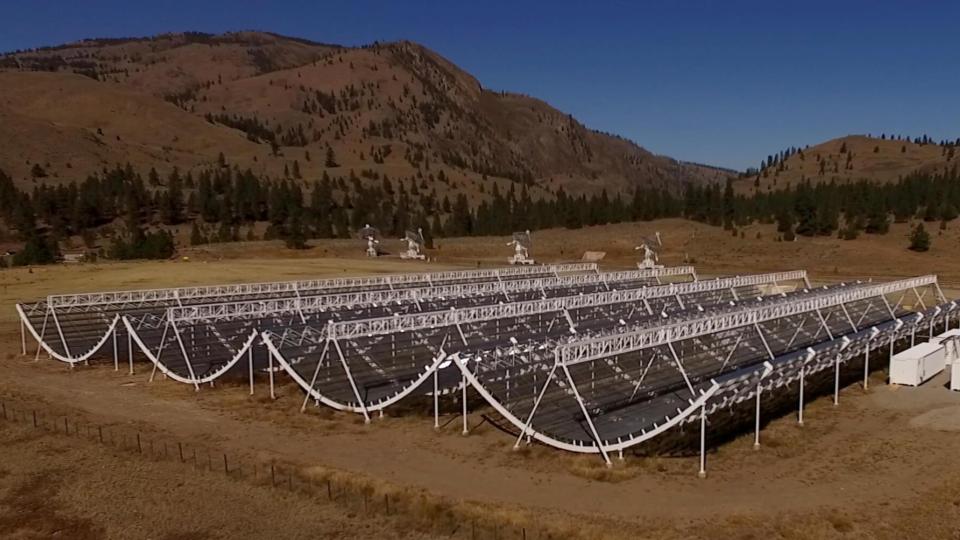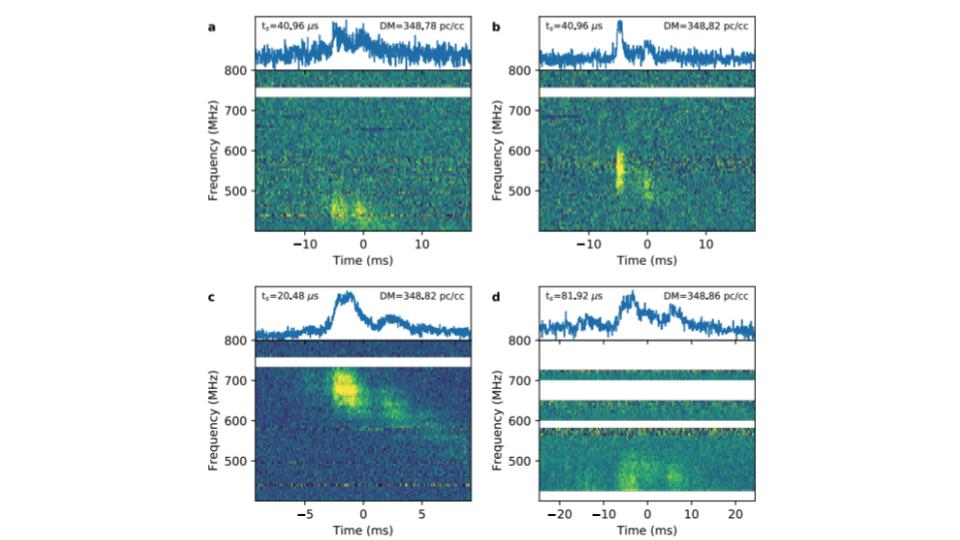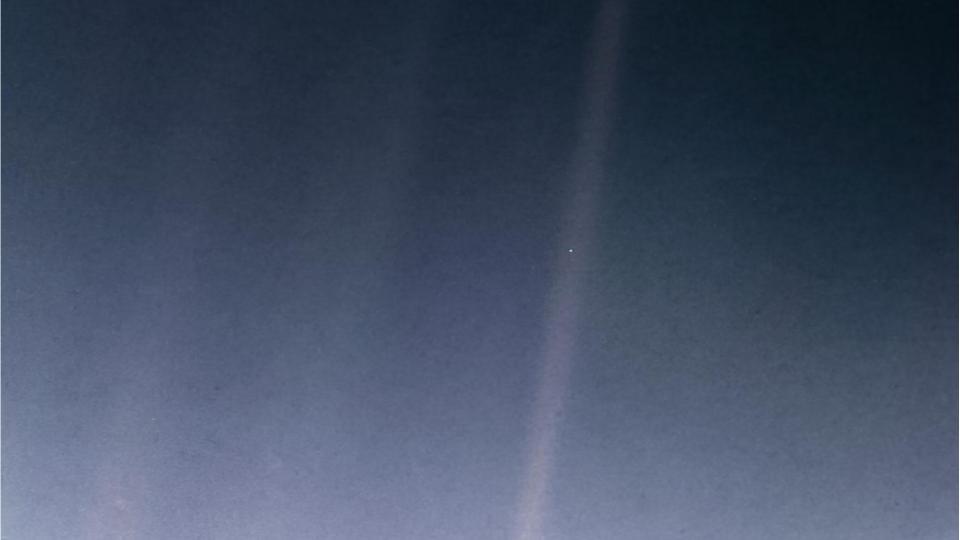We’ve been seeing a lot of reports about a possible alien signal from a weird radio source observed by the CHIME telescope. We look at the original research paper and sort fact from fiction (and the aliens are fiction). We also look at new efforts to work with the UN to limit the effects of satellite constellations on astronomy, and the reprocessing of Voyager 1’s famous Pale Blue Dot image.

- Periodic activity from a fast radio burst source (arXiv.org)
- Canada’s CHIME telescope detects second repeating fast radio burst (Phys.org)
This week twitter and popular media have been full of stories about a radio source that is giving off recurring, oddly patterned signals. The implication in many of these stories is these are signals from an alien civilization. The tweet that caught my eye said this source has a 16 day period, composed of 12 days of silence followed by 4 days of radio bursts every 2 hours. That super precise kind of weirdness is something I just couldn’t figure out a natural explanation for, so i decided go straight to the source of all this news: a preprint posted online by a large collaboration of researchers from the CHIME collaboration. In looking at that paper, yes, the radio source is weird, but it is nowhere near as weird as all the alien-assuming articles I’ve seen scattered across the internet.
So, let’s take a look at reality.
CHIME is a Canadian radio telescope that is mapping out the distribution of Hydrogen in the sky. This non steerable telescope studies the sky by literally watching the universe turn overhead. The 4 half-cylinder shaped antennas can see about and process data rapidly, and because there are multiple antenna, it’s possible to see and validate transient phenomena like random bursts from what are called Fast Radio Burst sources. These weird events aren’t understood, and the majority of them are a 1 off burst of unknown origin. Trying to understand these weird bursts is particularly hard because unlike Gamma Ray Bursts, they don’t have a partnered bright optical event we can use to locate their source and study their evolution.
Between September 16, 2018 and October 30, 2019 CHIME was able to observe repeating bursts from a source cataloged as FRB 180916.J0158+65. According to the not yet peer-reviewed preprint posted on ArXiv.org, they detected 28 bursts that, and I quote “arrive in a 4.0-day phase window, with some cycles showing no bursts, and some showing multiple bursts.” This 4-day window is within a larger 16.35 day period. This source is aligned on the sky with a star-forming region in a nearby spiral galaxy.
Let’s unpack that. Because this is a radio telescope, the source can be observed everyday, year round, but only during the parts of the day that it is over the detector, so there are lots and lots of gaps in the data. During 400 days of observation, they saw 28 bursts. Looking at a plot in their paper, it looks like the detector was observing during 22 of the 25 cycles that occurred during these 400 days, and those 28 bursts occurred during 12 of those 22 cycles. Again – there are gaps in the data because the Earth has this nasty habit of rotating, and the object isn’t over the detector all the time. And by gaps, I actually mean, the target is only over the detector for roughly 12 min a day, so it’s better to say there is a small daily observing window. To try and understand the system better, the team used the CHIME data to justify 3.5 hour observing run on the European Very Long Baseline interferometry network, and longer observing run on the steerable Effelsberg telescope, but bursts were determined to be at a frequency not visible to Effelsberg after that system failed to see 2 bursts seen at CHIME while they were simultaneously observing. So… continuous observations aren’t something they’ve been able to get in a wavelength they can see the bursts in. When they analyze the 28 detections, they can get a nice “during these 4 days per 16 days we see activity” window. Using 19 of those bursts, and the mathematical equivalent of a squint, they also find the bursts are roughly once per hour, give our take half an hour.

This is not a rigorously periodic signal. This is an object that is active and has bursts in a noisy way during a window of time that is recurring. This is something can be imagined to be a binary system.
To quote from the paper: “The discovery of a 16.35-day periodicity in a repeating FRB source is an important clue to the nature of this object. One possible explanation is orbital motion, with either a stellar or compact-object companion.” In the author’s discussion, they look closely at scenarios involving a neutron star and some kind of a companion star. They can’t find a perfect match, but they also don’t have a lot of data to build on, and we still have a long way to go in understanding how neutron stars and their magnetic fields interact with their environments.
This is a cool source. This preprint allows other researchers to know who found this cool object and to try and follow up and get the additional data that is needed to understand what this is. This isn’t aliens. The paper shows the burst observations spectra, and they are all slightly different in ways that screen “not an intelligent signal”. This is just cool science that may allow us to finally figure out what kinds of physics allow FRBs to exist.
Once again, this time with feeling. It is not aliens… it is never aliens… at least not until it is.

Ok, before we end this episode I have a couple quick updates. There will be another launch of Starlink satellites this week and as SpaceX fires off train after train of satellites, the astronomy community is leveling up on their attempts to deal with the resulting streaks of light. The International Astronomical Union has put out a new statement summarizing our current understanding of the impact constellations will have on observing. The key new piece of information in this statement, which we will link to on DailySpace.org, is that the IAU is now going to work with the UN Committee for Peaceful Uses of Outer Space to bring, and I quote, “the attention of the world Government representatives to the threats posed by any new space initiative on astronomy and science in general.” So, expect new attempts to prevent future satellites from being launched.

And finally, the original Pale Blue Dot image taken by Voyager 1 30 years ago has been reprocessed using modern software. The new image makes it easier to see the Earth and is generally just pretty. This was one of the last images taken by Voyager 1 before its cameras were shut down to conserve energy. You can see this image on our website, which once again, is DailySpace.org.
<———————>
And that rounds out our show for today.
Thank you all for listening. The Daily Space is written by Pamela Gay, produced by Susie Murph, and is a product of the Planetary Science Institute, a 501(c)3 non profit dedicated to exploring our Solar System and beyond. We are here thanks to the generous contributions of people like you. Want to become a supporter of the show? Check us out at Patreon.com/cosmoquestx


 We record most shows live, on Twitch. Follow us today to get alerts when we go live.
We record most shows live, on Twitch. Follow us today to get alerts when we go live.